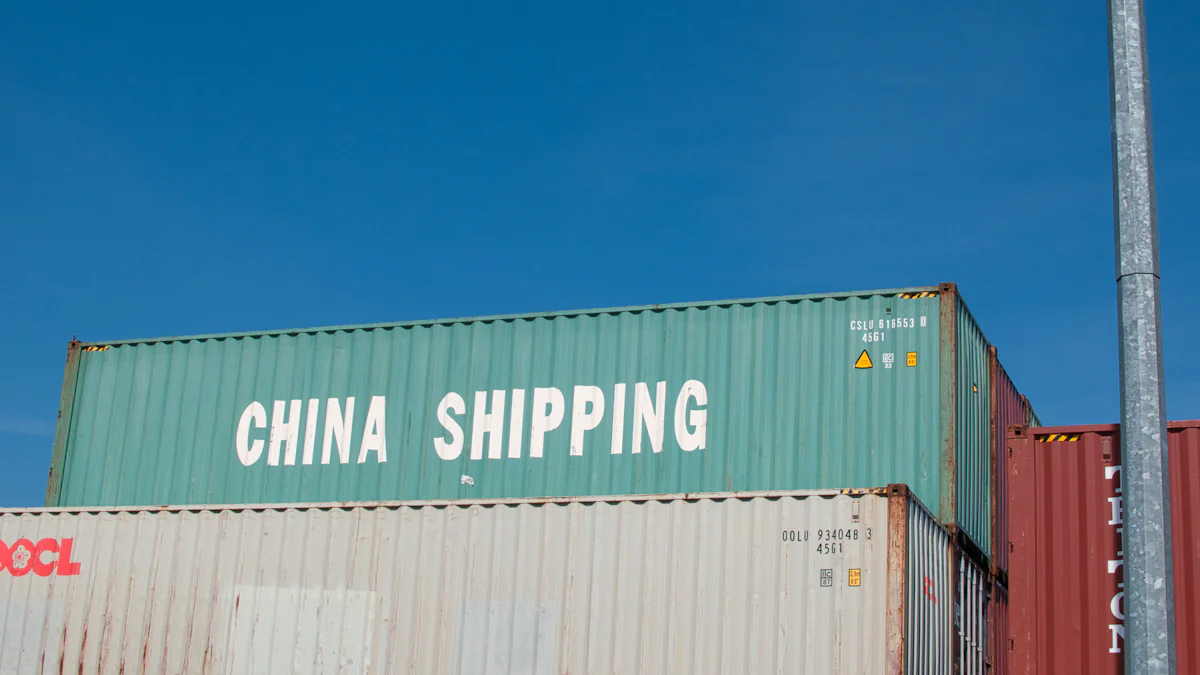Revolutionizing the Path: A Deep Dive into China-Vietnam Land Transport Evolution

China-Vietnam land transport holds immense significance for both nations. This corridor serves as a vital link for trade and economic cooperation. Analyzing recent trends in this sector reveals critical insights into infrastructure developments and strategic partnerships. The latest developments highlight the growing investments by Chinese enterprises in Vietnam's urban railways and high-speed rail projects. These advancements promise to enhance connectivity, reduce logistics costs, and boost the competitiveness of goods. Understanding these trends is crucial for stakeholders aiming to capitalize on emerging opportunities in the region.
Historical Context and Background
Early Developments
Initial Trade Routes
The initial trade routes between China and Vietnam date back to ancient times. Merchants transported goods along these routes, facilitating early economic exchanges. The Silk Road played a crucial role in connecting the two nations. This route allowed the flow of silk, spices, and other valuable commodities.
Early Agreements and Cooperation
Early agreements established formal trade relations between China and Vietnam. These agreements laid the groundwork for future cooperation. Diplomatic missions often accompanied these trade agreements. Such missions strengthened political ties and ensured smooth trade operations.
Evolution Over the Years
Major Milestones
Several major milestones marked the evolution of China-Vietnam land transport. The construction of the Kunming-Hanoi railway in the early 20th century stands out. This railway significantly boosted trade and connectivity. Another milestone includes the establishment of the China-ASEAN Free Trade Area in 2010. This agreement further enhanced trade relations between the two countries.
Key Infrastructure Projects
Key infrastructure projects have shaped the current landscape of China-Vietnam land transport. The Vietnam-China railway projects exemplify this development. These projects aim to connect Vietnam with Central Asia and Europe through China. The planned routes include Lào Cai – Hà Nội – Hải Phòng, Lạng Sơn – Hà Nội, and Móng Cái – Hạ Long – Hải Phòng. These railways promise to reduce logistics costs and increase the competitiveness of goods. The collaboration on these projects highlights the strategic importance of enhancing connectivity.
Latest Developments in China-Vietnam Land Transport

New Agreements and Policies
Bilateral Agreements
China and Vietnam have signed several new bilateral agreements to enhance land transport. These agreements focus on improving rail and road connectivity. The Vietnamese Prime Minister's visit to China has accelerated cooperation programs. Both countries aim to develop efficient railway systems. These agreements will facilitate smoother trade operations and economic growth.
Regional Cooperation Initiatives
Regional cooperation initiatives have also played a significant role. China and Vietnam participate in the Belt and Road Initiative (BRI). This initiative aims to improve infrastructure and connectivity across Asia. Vietnam plans to establish three railway links with China under BRI. These links will connect major cities and boost regional trade. Enhanced cooperation will lead to more robust economic ties.
Infrastructure Enhancements
Road and Rail Projects
Several road and rail projects are currently underway. Chinese enterprises invest heavily in Vietnam's infrastructure. These investments focus on urban railways and high-speed rail. The Vietnam-China railway projects aim to connect Vietnam with Central Asia and Europe. Key routes include Lào Cai – Hà Nội – Hải Phòng and Lạng Sơn – Hà Nội. These projects promise to reduce logistics costs and increase competitiveness.
Technological Advancements
Technological advancements have also improved land transport. Modern technologies enhance the efficiency of road and rail systems. JUSDA, a leading logistics provider, offers tailored transport solutions. The company uses advanced technologies like big data and IoT. These technologies ensure precise and reliable logistics support. Businesses can navigate the China-Vietnam land transport route more efficiently.
JUSDA
More than your expectation
Economic and Strategic Implications
Trade and Commerce
Impact on Bilateral Trade
The China-Vietnam land transport corridor significantly impacts bilateral trade. Enhanced connectivity reduces logistics costs, making goods more competitive. The three planned railway lines between Vietnam and China will lower product prices. This reduction will boost trade volumes and economic growth for both countries. Improved infrastructure facilitates smoother and faster transportation of goods. Businesses benefit from reduced transit times and increased reliability.
Key Commodities and Goods
Key commodities transported through this corridor include electronics, textiles, and agricultural products. Vietnam exports a large volume of textiles and garments to China. China supplies machinery, electronics, and raw materials to Vietnam. The efficient transport of these goods strengthens the supply chain. Both countries gain from the seamless flow of essential commodities. This exchange supports the manufacturing sectors in both nations.
Geopolitical Considerations
Strategic Importance
The strategic importance of the China-Vietnam land transport corridor cannot be overstated. This route serves as a critical link between Southeast Asia and Central Asia. The corridor enhances China's Belt and Road Initiative (BRI) by connecting major economic hubs. Vietnam benefits from improved access to international markets. This connectivity fosters regional stability and economic cooperation.
Regional Influence
The enhanced transport infrastructure boosts regional influence for both China and Vietnam. Improved rail and road networks attract foreign investments. Chinese companies invest heavily in Vietnam's infrastructure projects. These investments create jobs and stimulate economic growth. The collaboration between China and Vietnam sets a precedent for regional cooperation. Other ASEAN countries may follow suit, leading to broader economic integration.
"The three railway lines will help reduce logistics costs, lower product prices, increase competitiveness of goods, and create socio-economic development for both countries."
Future Prospects and Challenges

Planned Projects and Initiatives
Upcoming Infrastructure Projects
Vietnam plans to upgrade its railway infrastructure. The government seeks investments from Chinese enterprises. These projects include urban railways and high-speed rail lines. The North-South high-speed railway project stands out. This project aims to connect major cities in Vietnam. The Public-Private Partnership (PPP) model encourages private investment. This model attracts Chinese businesses to invest in Vietnam's railways.
The Belt and Road Initiative (BRI) plays a significant role. Vietnam plans to establish three railway links with China. These links will connect Lào Cai, Hà Nội, and Hải Phòng. Another route will link Lạng Sơn and Hà Nội. The third route will connect Móng Cái, Hạ Long, and Hải Phòng. These projects promise to enhance regional connectivity. Improved infrastructure will boost trade and economic growth.
Future Policy Directions
Vietnam aims to establish a unified standard framework for urban railways. This framework will ensure consistency in railway development. The government focuses on creating favorable policies. These policies will attract more foreign investments. Cooperation with China remains a priority. Both countries aim to develop efficient and modern transport systems.
The Vietnamese Prime Minister emphasizes the importance of infrastructure. The government seeks technological support from China. This support will help advance national and cross-border rail projects. Future policies will focus on enhancing transport connectivity. These policies will facilitate smoother trade operations.
Potential Challenges
Economic and Political Hurdles
Economic and political hurdles pose significant challenges. Funding remains a critical issue for large-scale projects. Securing investments requires favorable economic conditions. Political stability is essential for successful cooperation. Both countries must navigate complex political landscapes. Diplomatic relations play a crucial role in project success.
Trade tensions between China and other countries may impact projects. These tensions can affect investment flows and project timelines. Economic fluctuations also pose risks. Currency exchange rates and inflation can influence project costs. Both governments must address these economic challenges.
Environmental and Social Concerns
Environmental and social concerns must be addressed. Large infrastructure projects impact the environment. Construction activities can lead to deforestation and habitat loss. Both countries must implement sustainable practices. Environmental regulations should guide project development.
Social concerns also arise with large projects. Land acquisition can displace local communities. Compensation and resettlement plans must be fair. Public consultations should involve affected communities. Addressing these concerns ensures project acceptance. Sustainable development benefits both nations.
"The three railway lines will help reduce logistics costs, lower product prices, increase competitiveness of goods, and create socio-economic development for both countries."
Future prospects for China-Vietnam land transport look promising. Planned projects and initiatives will enhance connectivity. However, potential challenges must be addressed. Economic, political, environmental, and social factors play crucial roles. Successful cooperation will lead to significant benefits for both nations.
Recent trends in China-Vietnam land transport reveal significant infrastructure developments and strategic partnerships. These advancements highlight the importance of this corridor for trade and economic growth. Leading Chinese enterprises are increasing investments in Vietnam's urban railways and high-speed rail projects. These investments promise enhanced connectivity and reduced logistics costs. Future prospects look promising with planned projects and initiatives. Addressing potential challenges will ensure successful cooperation. Enhanced transport infrastructure will boost regional influence and economic integration, benefiting both nations.
See Also
Ready to Explore: The Latest in Transport Tech for Supply Chains
Mastering Sustainable Transport in Supply Chains
2024 Revealed: Innovations in Sea Freight Logistics
